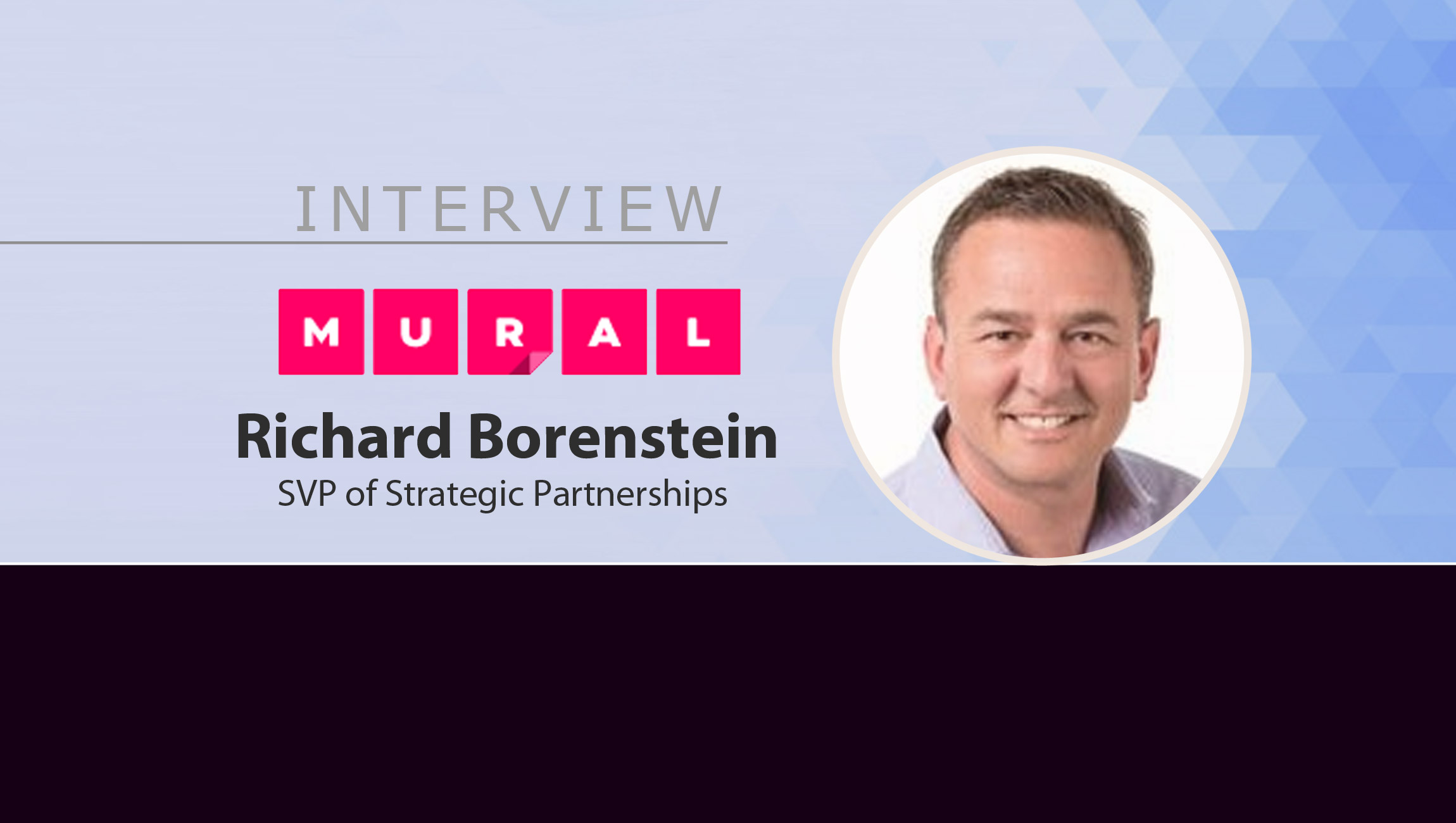Richard Borenstein, SVP of Strategic Partnerships at MURAL joins us for a chat on the increasing use and capabilities of AI on visual platforms while taking us through a few of MURAL’s latest innovations:
______
Welcome to this MarTech Series chat, Richard! Tell us more about yourself, we’d love to hear about your journey through the years.
Sure, thanks for having me, Paroma!
My name is Richard Borenstein and I’m the SVP of Strategic Partnerships at MURAL, which offers digital workspaces for guided visual collaboration in the enterprise. I joined MURAL in October 2020 after serving in sales management positions for over 25 years at companies like Highfive (acquired by Dialpad), RingCentral, and Zong (acquired by PayPal).
I’m what you consider a SaaS veteran, with an extensive, worldwide executive network leading long-term partnerships. I joined MURAL to accelerate the company’s revenue growth and market penetration, forming deep, integrated partnerships with enterprise brands like Microsoft, Zoom, Atlassian, and Cisco. Together, we are bringing guided visual collaboration to the enterprise collaboration toolkit.
Marketing Technology News: MarTech Interview with Einat Etzioni, CMO at Namogoo
What inspired the story of MURAL and how has the platform evolved over time?
MURAL was founded in 2011 as a digital whiteboard for people to collaborate in real-time, but it has since evolved to deliver across multiple capacities. The idea of MURAL came about when the founders, Mariano, Pato and Agustin, were designing video games for Disney (after having sold their previous company Three Melons to them) and had to interact with colleagues who were distributed all over the world. The process at the time was chaotic, where Mariano was sending static slide decks back and forth to his colleagues, which had a detrimental impact on time and output. It was very difficult to collaborate and co-create remotely as they did when they were in person in meeting rooms.
Then in 2014, MURAL completed the Startup-in-Residency Program at IDEO, which injected human-centered design principles into the product model. This helped MURAL redesign its business model and expand its visual collaboration solution for the enterprise around experience design, agile development and remote work needs. IDEO’s mentor team introduced the founders to companies who would go on to become key customers today, with the most notable being IBM.
Today, MURAL supports over 75 percent of Fortune 100, offering secure, digital workspaces for guided visual collaboration. The platform transforms teamwork by making meetings and workshops truly interactive experiences designed for problem solving, play, and imagination. Teams in product, consulting, leadership, innovation, technology, and sales and customer success, collaborate visually with MURAL. The platform makes it possible to deploy at scale over 250+ pre-built templates for team activities like brainstorming, product roadmaps, OKR planning, user journey maps, team building, icebreakers, and so much more. Tens of thousands of teams at companies such as IBM, Intuit, Facebook, Publicis Sapient, USAA, SAP, Thoughtworks, and Atlassian, use the platform to foster inclusive, imaginative teamwork and turn shared ideas into a reality—at any time and from anywhere.
We’d love to hear more about the new MURAL App for Zoom and how this is going to benefit end users and visual / communications teams?
Sure! We recently introduced the new MURAL App for Zoom, which adds a new visual dimension to collaboration by making video meetings more productive, engaging, and playful. Previously, anyone could share their screen but now, with Zoom Apps, the shared content stays inside your Zoom interface.
As an official launch partner for Zoom Apps, it’s possible to share a MURAL digital canvas during a Zoom Meeting where all attendees—even those without a MURAL account—can collaborate in real time with digital sticky notes, drawings, diagrams, images, voting and more. Members can leverage MURAL’s Facilitation Superpowers features and hundreds of pre-made templates to increase participation, drive decision making, and build camaraderie and connection.
The MURAL App for Zoom is free and available in the Zoom App Marketplace. Only the Zoom meeting owner needs to be a MURAL member or free trialer — everyone else can join as a visitor, which doesn’t require a MURAL account.
Can you share your thoughts on the growing impact of AI on visual platforms and how you feel this space is set to evolve in future?
Visual platforms like MURAL are a whole new media format – as different from most other “business tools” as books are from 3D movies or roller coasters. At its core, visualization helps teams find new insights and new patterns. The aim is to see (literally) how concepts relate to one another in new ways. With just a little metadata, AI can both accelerate finding new insights and see patterns that humans can’t. For instance, if a team is developing new ways to better serve customers, creating a map of the customer experience can show opportunities by visual inspection. AI can go beyond what’s on the surface and triangulate patterns not visible to humans. The combination of the two–visual thinking plus AI–will be a competitive advantage to any organization.
However, while AI can take some of the processing weight off of people, it won’t replace their ability to imagine. Sure, AI could calculate all possible permutations in solving a given problem with brute force, but AI cannot (yet) replace the human ability to imagine a better future. That part of the future of work is going to be the last to be automated. Visualizing what’s possible will allow us as humans to be able to have a better dialog and ultimately achieve more together.
In what ways do you feel brands / marketers can create better online meeting experiences with visual collaborative features, to drive better conversations and engagement?
It’s an important question: how do you make the best use of people’s time? We advocate to incorporate methods of facilitation into how you design your meetings, re: pre work and post work for meetings, so your time IN meetings is more productive. This way, when teams DO get together in person, there’s time for playful participation and a productive use of time. We want everyone to feel involved in the process.
On a micro level, we aim to do more asynchronously, eliminating unnecessary meetings. We share videos, write-ups, or MURAL visualizations beforehand so teammates come prepared, and then we maximize our time meeting together. At the end of a productive meeting, we come to a consensus, assign action items, and take time to reflect on the meeting itself. This gives us a way of continuously learning and improving.
Another practice we’ve been using, first at the leadership team level and now deploying across the company, is starting meetings by asking how our teammates are feeling, both physically and emotionally. Sometimes it’s hard to perform at your highest level — you might be sick, jetlagged, or have something going on in your personal life — and it’s important to acknowledge that before the meeting starts.
Marketing Technology News: MarTech Interview with Lisette Huyskamp, CMO at Productsup
We’d love to hear about a few upcoming innovations in store at MURAL. What can users look forward to in the near-future?
While we cannot share the roadmap, we can talk about the blueprint. Following the launch of our mapping and diagramming features this March, we are working on features around venn diagramming, adding data to MURAL, enhanced voting and tagging elements within a mural. Then adding playful guided methodologies — like follow me, celebrations, timer, etc. We are also more fully integrating into enterprise collaboration solutions like Microsoft Teams, Webex, and Zoom. Finally, we are working on adding localization to the platform.
We’d love to hear some highlights from leading brands and how you’ve seen them create enriching experiences with your visual platform?
More than six years ago, IBM pioneered the change at scale through its IBM Enterprise Design Thinking and Agile programs. They curated a series of methods and experts in their company and set the mission to transform how 400k IBMers worked. They were digital-first before the pandemic, and they were able to proceed with business as usual during the pandemic. They are now a case study in Harvard Business School. Additionally, a Forrester study revealed the economic impact of IBM’s implementation of MURAL had a 495% return on investment.
Last year the revenue team at Spotify could no longer do OKR planning face-to-face. So Emem Adjah, then global head of monetization, made the workshop digital with MURAL. She facilitated exercises with her team, connecting the dots between the company vision and its impact on revenue. She ran breakout sessions for brainstorming and prioritizing key results. Doing this work with her team online saved time. It also fostered alignment by putting everyone on the same virtual page. Emem’s team discovered they could continue working in this new way. They could combine methods and visual collaboration whenever and wherever they wanted.
Stories like these are becoming very common:
- Thoughtworks’ global leadership had to forgo their prioritization offsite, so they quickly pivoted and discovered they could take that off site online.
- Booz Allen adapted their PI planning workshop to work for 300+ remote participants (all new to remote workshops). Once the dust settled, they delivered all quarterly commitments and increased delivery by 30%.
- The Publicis Sapient product teams have also discovered how they can work visually together in MURAL to create alignment, even when the work is particularly complex. Sheldon Monteiro, EVP and chief product officer, shared that, “Real customer centricity requires input and alignment from cross-functional teams. This is especially hard to accomplish without a shared canvas to build understanding. Our Customer Experience & Innovation experts found they could build journey maps faster using MURAL to brainstorm, synthesize ideas, facilitate alignment, teamwork and trust. The result was faster — and stronger — consensus with client stakeholders.”
Marketing Technology News: MarTech Interview with Lorn Davis, VP of Corporate and Product Strategy at Facteus
 MURAL is a provider of digital workspaces for guided visual collaboration in the enterprise. Different from online whiteboarding and design software, the MURAL® platform transforms teamwork by making meetings and workshops interactive experiences designed for problem solving, play, and imagination. Richard Borenstein is the SVP of Strategic Partnerships at MURAL, responsible for accelerating the company’s revenue growth and market penetration, forming deep, integrated partnerships with enterprise brands, and leading a highly skilled sales team bringing visual collaboration to the enterprise.
MURAL is a provider of digital workspaces for guided visual collaboration in the enterprise. Different from online whiteboarding and design software, the MURAL® platform transforms teamwork by making meetings and workshops interactive experiences designed for problem solving, play, and imagination. Richard Borenstein is the SVP of Strategic Partnerships at MURAL, responsible for accelerating the company’s revenue growth and market penetration, forming deep, integrated partnerships with enterprise brands, and leading a highly skilled sales team bringing visual collaboration to the enterprise.
Richard Borenstein is the SVP of Strategic Partnerships at MURAL
Catch the latest B2B Marketing and Sales Conversations with these latest episodes of The SalesStar Podcast!
Episode 93: How Do You Build An Impactful Customer Success Model: With Daljit Bamford, Tenth Revolution Group
Episode 92: B2B Marketing Learnings And Martech Tips With Jon Perera, CMO At HighSpot
Episode 91: Top Trends And Concerns Of B2B Revenue Teams: With Sylvia Ananicz, Head Of Revenue At Lilt











